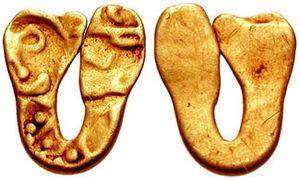Larin (currency) facts for kids
| Gold Indian Larin | |
|---|---|
 |
|
| Three punches: two with Kannada inscriptions, one with uncertain animal. | |
| Circa 12-13th century, from "Walve Hoard" | |
A larin (plural: lari) was a special kind of coin used a long time ago. It was popular in countries around the Arabian Sea. People believe the first larin coins came from a town called Lar in Iran.
Contents
What Did a Larin Look Like?
A larin wasn't a round coin like we use today. It was a piece of silver wire, about 10 centimeters long. It was usually folded in half, making it look like the letter "C". Sometimes, they looked like "J", "I", or "S". Each larin had words stamped on it, usually in Arabic or Persian. These words often showed the name of the local ruler.
Larin in Sri Lanka
In Sri Lanka, the larin was also known as "Koku Ridi," which means "Silver Hook." It was used in the Kandyan Kingdom from the 1600s to the early 1800s. Private groups made these coins. Five larin coins were worth one "piece-of-eight," which was a Spanish dollar.
Fish-Hook Shape
These coins often looked like a fish-hook. They usually had no clear writing, or only faint copies of Arabic letters. They were often thick and short. You might see one or more cuts near the bend. These cuts were probably made to test how pure the silver was.
Widespread Use and Value
Silver larin coins first appeared in the Persian Gulf. They were used widely along the coast of the Indian Ocean, reaching as far as Sri Lanka. This happened during the 16th and 17th centuries. Larins used in Sri Lanka were bent into the "fish-hook" shape. Larins from other areas were usually straight.
Lankan Larins
Larins made in Sri Lanka had either fake Persian writing or just meaningless designs. Some reports say that larins with Western writing were also made there. Larins from more northern places that arrived in Sri Lanka through trade were often bent into the "fish-hook" shape later on. This was done when they became part of the island's money system.
Weight and Exchange
A larin from the 1600s would weigh about 4.75 grams. It was usually valued at 5.5 lari for one Spanish colonial piece of eight.
Modern Connections
The word "lari" is the root of coin names used today in other countries. For example, the money in Georgia is called the Georgian lari. The money in the Maldives is called the Maldivian laari.

